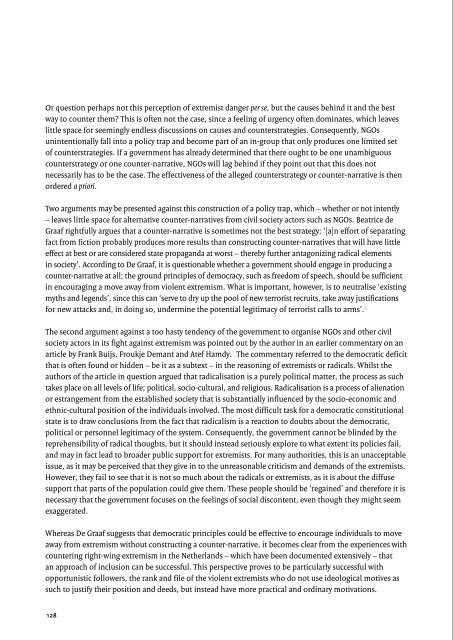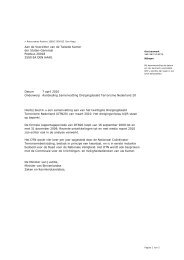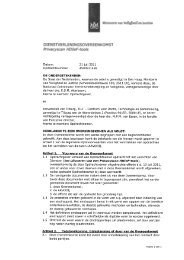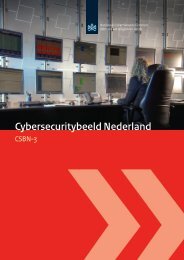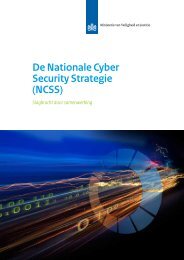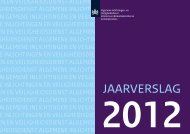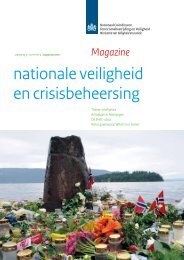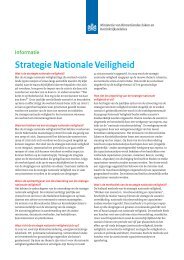Countering Violent Extremist Narratives
Countering Violent Extremist Narratives
Countering Violent Extremist Narratives
- No tags were found...
Create successful ePaper yourself
Turn your PDF publications into a flip-book with our unique Google optimized e-Paper software.
Or question perhaps not this perception of extremist danger per se, but the causes behind it and the bestway to counter them? This is often not the case, since a feeling of urgency often dominates, which leaveslittle space for seemingly endless discussions on causes and counterstrategies. Consequently, NGOsunintentionally fall into a policy trap and become part of an in-group that only produces one limited setof counterstrategies. If a government has already determined that there ought to be one unambiguouscounterstrategy or one counter-narrative, NGOs will lag behind if they point out that this does notnecessarily has to be the case. The effectiveness of the alleged counterstrategy or counter-narrative is thenordered a priori.Two arguments may be presented against this construction of a policy trap, which – whether or not intently– leaves little space for alternative counter-narratives from civil society actors such as NGOs. Beatrice deGraaf rightfully argues that a counter-narrative is sometimes not the best strategy: ‘[a]n effort of separatingfact from fiction probably produces more results than constructing counter-narratives that will have littleeffect at best or are considered state propaganda at worst – thereby further antagonizing radical elementsin society’. According to De Graaf, it is questionable whether a government should engage in producing acounter-narrative at all; the ground principles of democracy, such as freedom of speech, should be sufficientin encouraging a move away from violent extremism. What is important, however, is to neutralise ‘existingmyths and legends’, since this can ‘serve to dry up the pool of new terrorist recruits, take away justificationsfor new attacks and, in doing so, undermine the potential legitimacy of terrorist calls to arms’. 6The second argument against a too hasty tendency of the government to organise NGOs and other civilsociety actors in its fight against extremism was pointed out by the author in an earlier commentary on anarticle by Frank Buijs, Froukje Demant and Atef Hamdy. 7 The commentary referred to the democratic deficitthat is often found or hidden – be it as a subtext – in the reasoning of extremists or radicals. Whilst theauthors of the article in question argued that radicalisation is a purely political matter, the process as suchtakes place on all levels of life; political, socio-cultural, and religious. Radicalisation is a process of alienationor estrangement from the established society that is substantially influenced by the socio-economic andethnic-cultural position of the individuals involved. The most difficult task for a democratic constitutionalstate is to draw conclusions from the fact that radicalism is a reaction to doubts about the democratic,political or personnel legitimacy of the system. Consequently, the government cannot be blinded by thereprehensibility of radical thoughts, but it should instead seriously explore to what extent its policies fail,and may in fact lead to broader public support for extremists. For many authorities, this is an unacceptableissue, as it may be perceived that they give in to the unreasonable criticism and demands of the extremists.However, they fail to see that it is not so much about the radicals or extremists, as it is about the diffusesupport that parts of the population could give them. These people should be ‘regained’ and therefore it isnecessary that the government focuses on the feelings of social discontent, even though they might seemexaggerated.Whereas De Graaf suggests that democratic principles could be effective to encourage individuals to moveaway from extremism without constructing a counter-narrative, it becomes clear from the experiences withcountering right-wing extremism in the Netherlands – which have been documented extensively – thatan approach of inclusion can be successful. This perspective proves to be particularly successful withopportunistic followers, the rank and file of the violent extremists who do not use ideological motives assuch to justify their position and deeds, but instead have more practical and ordinary motivations.Heterogeneous counter-narrativesThe effective inclusion perspective demonstrates that a counter-narrative in itself is not objectionable.However, the manifestation of this counter-narrative is of utmost importance. In order to effectivelyoppose threats such as jihadist extremism, the government should not try to incorporate civil actors intoone single counter-narrative, but instead stimulate the production of plural oppositions, or heterogeneouscounter-narratives. Social diplomacy, conducted by a variety of independent civil actors, may facilitate sucha strategy.A similar plea for heterogeneity is made by Paul Frissen in a recent publication. 8 He claims that thepolitical exists by the grace of difference since politics’ primary function is to channel conflicting positions.Consequently, narratives that aim to annul all other narratives – as is for instance the case with populistnarratives – are in essence a-political. Such single narratives contradict the fundamental principles ofdemocracy. Therefore, dissimilarity needs to be regarded as the basis of politics and not as somethingthat should be opposed. Thus, the counter-narrative that is formulated as a response to violent (jihadist)extremism should be a heterogeneous one. In this way, counter-narratives will express the democraticdiscourse.This is an essential point when dealing with extremists that oppose democracy and its very core values.In order to convey the indispensability of democratic practice and values, counter-narratives need torepresent this message in both content and form. Producing a single counter-narrative, something thatgovernments may be inclined to do when having to oppose extremist violence, in fact goes against thedemocratic values that they attempt to guard with their counter-narrative in the first place. Thus, in orderto effectively oppose extremism within a democratic discourse, heterogeneous counter-narratives thatrepresent the fundamental nature of politics, namely dissimilarity, should be produced. Social diplomacyconducted by various civil society actors, combined with public diplomacy, enables and stimulates suchheterogeneous counter-narratives.ConclusionIn the fight against jihadist extremism – and perhaps every other form of ideologically, religiously orethnically motivated extremism – cooperation between national and local governments on the one handand citizens and civil society organisations on the other, will prove of great use. This cooperation will havethe most impact when the right mix of public and social diplomacy is applied. The coordination of theseefforts will be the responsibility of the government, but in the cooperation there needs to be enoughspace for an autonomous role of citizens and organisations, since a heterogeneous approach to fightingextremism will be most successful. This implies that various forms of this approach need to be developed:repressive (government), preventive (in cooperation) and restorative (mostly NGOs with the assistance ofthe government). The necessary counter-narratives – be it the citizens of Amsterdam against extremism,democrats against anti-democrats, or non-violent citizens and organisations against violent extremistsand their organisations – have to be heterogeneous as well, in order for them to express the democraticdiscourse. They should therefore not be subordinate to the ruling paradigm that the government imposes.Hence, the fight against violent extremism is a democratic and civil task in which all parties involved –the government, NGOs and individual citizens – have to be fully aware of their own responsibilities andautonomy. In the fight against extremism, freedom and democracy cannot become the ultimate victims.128 129


